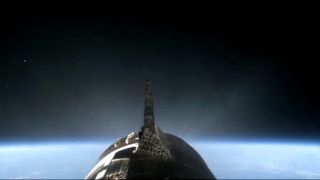The fourth test flight of the biggest and most powerful rocket ever built is in the books, and what a dramatic and nail-biting trip for SpaceX it was.

SpaceX launched its Starship megarocket for the fourth time ever today (June 6) at 8:50 a.m. EDT (1250 GMT), sending the 400-foot-tall (122 meters) vehicle aloft from its Starbase site near Boca Chica Beach in South Texas atop a thundering pillar of fire.
There were two main goals today: bring Starship's first-stage booster, known as Super Heavy, down for a soft splashdown in the Gulf of Mexico, and achieve a controlled reentry of the 165-foot-tall (50 m) upper stage, called Starship or simply Ship. Both the Super Heavy booster and its Ship appeared to make their water landings, sending spectators at SpaceX's mission control at Starbase into a frenzy of cheers.
"This whole building was going absolutely insane," SpaceX spokesperson Dan Huot said during live commentary from the company's headquarters in Hawthorne, California. "When we saw the booster hit the water, I mean, wow."
Elon Musk, SpaceX's founder and CEO, was thrilled.
"Successful soft landing of the Starship Super Heavy rocket booster!" he wrote on X (formerly Twitter) after splashdown.
The Starship Ship vehicle, meanwhile, appeared to nail its landing burn despite one of its flaps clearly suffering burn-through damage during descent. Live camera views showed the flap's heat shield burn away, covering the the camera with debris, then ultimately cracking the lens.
Still, the camera came back despite several signal drops, proving each time that Starship was alive. At landing, the Ship appeared to flip as planned and execute its landing burn, SpaceX said.
"Despite loss of many tiles and a damaged flap, Starship made it all the way to a soft landing in the ocean!" Elon Musk wrote on X later. "Congratulations SpaceX team on an epic achievement!!
The crowd, as you'd expect, went wild.
"It was so loud here," Kate Tice, SpaceX quality systems engineering senior manager, said during live commentary. "I haven't heard the crowd get that loud, probably, since Flight One."

Tice, Huot and SpaceX's Jessie Anderson celebrated the Starship landing by toasting a marshmallow with a Starship-shaped lighter.
Related: Relive SpaceX Starship's 3rd flight test in breathtaking photos
Starship views the fully reusable Starship as a revolutionary advance in spaceflight, one that could make human settlement of the moon and Mars economically feasible at long last.
Indeed, the vehicle was designed with Mars in mind: Its next-gen Raptor engines (33 for Super Heavy and six for Ship) burn liquid oxygen and liquid methane, both of which can be sourced on the Red Planet.
The moon will likely be Starship's first far-flung stop, however. NASA selected the craft as the first crewed lander for its Artemis program of moon exploration, which aims to establish a research base in the ice-rich south polar region by the end of the 2020s. The current architecture calls for Starship to land NASA astronauts on the moon for the first time in September 2026, on the Artemis 3 mission.
Starship will need to ace many more test flights before it's ready for that landmark mission, but the stainless-steel spacecraft is off to a good start: It has made significant progress on each of its four liftoffs to date.
Starship's two stages failed to separate on its debut flight, which occurred in April 2023. That mission ended with a controlled detonation of the tumbling vehicle just four minutes after liftoff. (And that liftoff blasted a crater beneath Starbase's orbital launch mount, impelling SpaceX to install a water-spewing metal plate as heat-wicking reinforcement.)
Flight 2, in November 2023, achieved stage separation but still ended early; both Ship and Super Heavy had been reduced to swirling bits in Earth's atmosphere by eight minutes after launch.
Starship made a big leap on Flight 3, which launched on March 14 of this year. Stage separation occurred on time, and Super Heavy made it to within 1,650 feet (500 meters) of the Gulf of Mexico's wavetops before breaking apart. Ship, meanwhile, achieved orbital velocity and flew for nearly 50 minutes, finally succumbing to intense frictional heating as it reentered our atmosphere after an uncontrollable roll due to loss of its reaction control system, SpaceX said.
Flight 4 saw yet more improvement, as the Super Heavy made it safely down to the water while the Ship appeared to maintain roll control during flight.
During launch, the Super Heavy booster appeared to fire 32 of its 33 Raptor engines during liftoff, with one engine clearly out in video and telemetry. When the Super Heavy fired its 13-engine landing burn, only 12 engines fired, but the booster still appeared to make its "soft landing" splashdown, SpaceX said.
If you missed today's liftoff, don't worry: There will probably be many more Starship launches in the near future. SpaceX founder and CEO Elon Musk has said the company aims to launch six test flights of the megarocket in 2024, which would work out to four more liftoffs in the next six months.
The timeline is not entirely up to SpaceX, of course; regulators such as the Federal Aviation Administration have a say. But, true to its fast-moving ways, SpaceX has already been gearing up for the coming Starship launches. It test-fired the Flight 5 vehicle early last month, for example.































